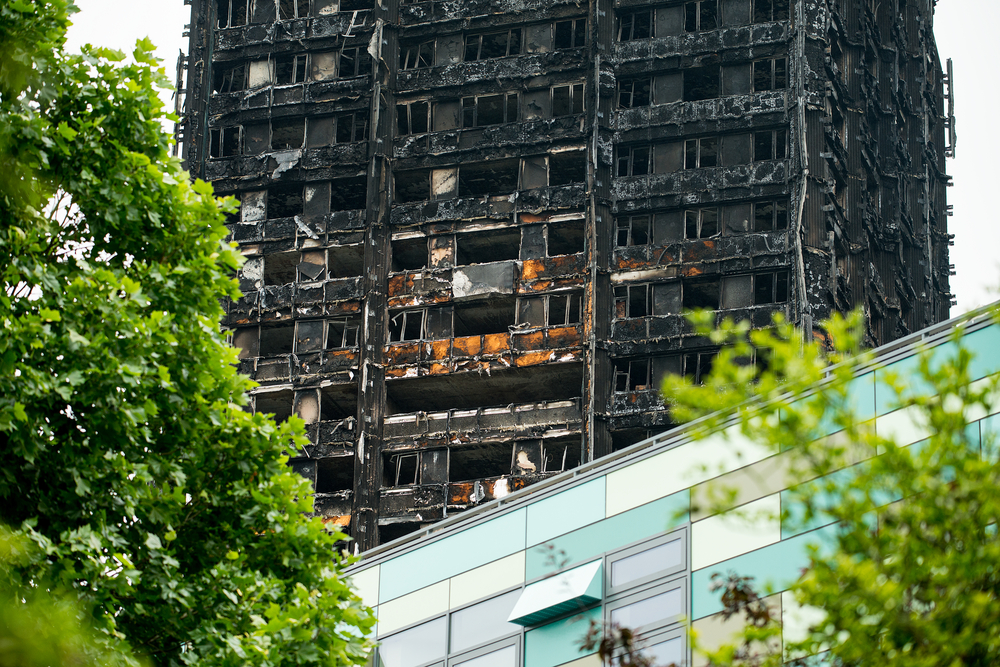
Grenfell Tower Fire – The Law of Unintended Consequences – Professional Indemnity Insurance Claims and Rising Premiums
The Grenfell Tower fire was a disaster which affected a great many people in this country. For town planners, building designers, building control specialists, contractors, emergency services and our industry in general, it marked a very low point in our industry’s history and evolution.
In response to this terrible incident the Government commissioned an enquiry in order to obtain a report and recommendations on how our regulatory system should be modified to restore confidence in the design, construction and management of high-rise buildings. Dame Judith Hackett produced her final report “Building a Safer Future – Independent Review of Building Regulations and Fire Safety” in May 2018. We will have to wait and see if our Government decides to implement all of the recommendations contained in the report but, as a start, the use of aluminium composite materials (“ACM”) in high-rise buildings was banned in December 2018. Our Government has also made funding available to registered social landlords and other public building owners to have ACM materials removed from existing buildings and has given local authorities powers to remove ACM materials from privately owned buildings and pursue the building owners for the resulting costs.
I suspect that nobody will criticise these first steps by our Government or its approach to adopting a “safety first” strategy, leaving the financial consequences to be worked out at a later date. So, why is this so important and how does it affect the construction industry and the insurance market?
With some estimates as high as 500 affected buildings (nobody really knows how many are out there), the availability of funding for public bodies, and local authorities armed with new powers to compel reluctant building owners to take action, it is perhaps not surprising that our industry is experiencing a surge in activity to identify affected buildings, draft remedial solutions and engage in the procurement of these corrective works. But what comes afterwards?
I can’t say I am a fan of the “where there’s blame there is always a claim” culture that now pervades our way of life but it is what it is and the reality is that there is a flurry of activity to identify whether any party can be blamed for adopting the use of ACM cladding systems on buildings in the UK so that legal action can be started against those parties which are left “holding the baby” and who are “caught in the firing line”.
So why is this so important? Well, it comes down to a simple question. Do we know for sure that insurers will end up writing cheques to settle the large claims that will follow? The answer, as with most things in life, is that there is no guarantee that this will be the case.
Leaving aside the important issues of an insurance policy’s scope and cover and whether a claimant can prove negligence against an insured defendant for one moment, there are two important features of professional indemnity insurance policies (“PI policy”) that we need to consider further.
The first feature is that each PI policy of insurance will contain a retroactive date. This is the date that cover commenced and this will not change in subsequent years of insurance as long as you stay with the same insurer.
The second feature of this type of insurance is that it is arranged on what is referred to as a “claims made basis”. In other words, as long as the premium is paid in any one period of insurance (usually a calendar year), the policy will respond if a claim is made. If the premium isn’t paid, the policy immediately lapses and so too does the insurance cover.
In reality this means that there is a substantial increase in the number of notifications being issued to insurers by designers and contractors up and down the country that might be caught in the ACM debacle. The rise in notifications and actual claims, not surprisingly, has caused insurers to look at the premiums being charged as well as the type of cover being offered. Some insurers are withdrawing from the Professional Indemnity Insurance market, some are switching cover from an “each and every claim” basis to an “any one claim and in all” or “aggregate” basis and all are looking at exposure to potential claims in this area, hiking insurance premiums and in some cases refusing to renew policies at all.
Questionnaires designed by insurers at policy renewals are looking to identify potential areas of risk. Any designer involved historically in the selection of ACM cladded buildings, which now have to be replaced, is in distinct danger of facing a claim from those parties affected.
Up and down the country difficult conversations are taking place between Consultants and Contractors, involved with ACM cladded buildings, and their insurers:
- Will a PI policy renewal even be offered?
- What will be the increase in insurance premium?
- Can they afford the premiums?
- Should the PI policy be lapsed and started again in order to amend the scope of historical cover?
- Where will this leave clients with the plethora of warranties signed in the past and agreeing to maintain PI insurance for 12 years?
- What options are open to them to manage these concerns?
- How will this impact building owners and tenants affected by these issues?
It remains to be seen how the inevitable claims will ultimately be dealt with and, perhaps more importantly, who will end up paying the resulting bills. There is a school of thought that the responsibility for the Grenfell Tower fire and resulting claims should all fall on Central Government. At the moment, however, there is no sign that our Government will accept any responsibility for the incident. The blame and claim game is therefore likely to go on for some years ahead.
The Vinden Partnership is currently involved in multiple projects where it is assisting building owners and tenants with building owners affected by ACM cladding systems. But we are also seeing Consultants and Contractors who are now experiencing problems with their PI insurance renewals. Every effort has to be made to avoid a repeat of the Grenfell Tower fire. What we don’t know yet is what the total cost of putting things right will be and who will end up footing the bill. The fall-out of this disaster is clearly set to affect many people and for many years to come.
If you are affected directly or indirectly by any of the above matters and need discrete and confidential advice on dealing with these sorts of issues, please do not hesitate to get in contact.
Peter Vinden is Chief Executive of The Vinden Partnership and he can be contacted by email at pvinden@vinden.co.uk. For similar articles please visit www.vinden.co.uk.





